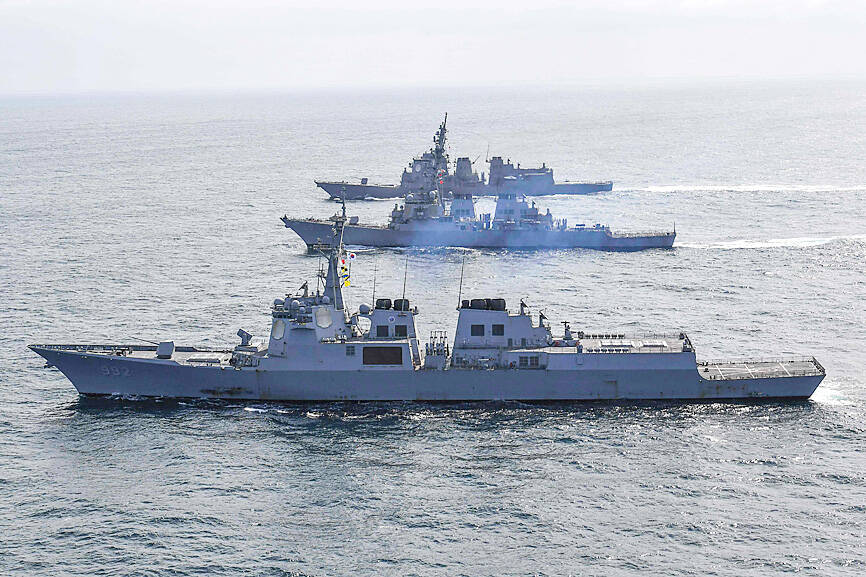South Korea, the US and Japan yesterday staged joint naval missile defense exercises in a push to improve security cooperation and respond better to North Korea’s evolving missile threats, Seoul’s navy said.
The three nations agreed at talks in Washington on Friday to hold regular missile defense and anti-submarine exercises in their efforts to boost diplomatic and military cooperation.
North Korea tested a new solid-fuel intercontinental ballistic missile on Friday that experts say would ease the way for missile launches with little warning, part of an increase in its military activities in the past few weeks.

Photo: AFP / South Korean Ministry of National Deense
Yesterday’s drills in international waters between Korea and Japan bring together South Korea’s 7,600-tonne Aegis destroyer Yulgok Yi I, the US guided-missile destroyer Benfold and Japan’s Atago destroyer, also equipped with Aegis radar systems.
The effort focuses on mastering response procedures, from detection and tracking to information sharing, by creating a virtual target in a scenario featuring a North Korean ballistic missile provocation, the South’s navy said.
“It is an opportunity to strengthen trilateral security cooperation against North Korea’s escalating nuclear and missile threats,” Captain Kim Ki-young of the South Korean destroyer said in a statement.
This would solidify the navy’s capability and posture to respond to ballistic missiles, he added.
The Japanese Ministry of Defense said the exercises promote trilateral cooperation over regional security challenges, and demonstrate the three nations’ strong commitment to secure a free and open international order based on the rule of law.
Pyongyang has threatened “more practical and offensive” action as South Korean and US forces have performed annual springtime exercises since last month, some involving Japan, which the North has described as a rehearsal for nuclear war.
Separately, the air forces of South Korea and the US were yesterday set to begin drills for a 12-day run.
Also yesterday, South Korea and Japan resumed “two-plus-two” talks of senior diplomatic and security officials in Seoul after a five-year halt, as ties thaw after a years-long feud over issues of wartime history.
They shared views on North Korea and regional issues, while agreeing to improve understanding of each other’s policies and foster security cooperation in a “forward-looking” way, Seoul’s foreign and defense ministries said in a joint statement after the meeting.
South Korean President Yoon Suk-yeol, who has pledged to move ties with Japan beyond the past, last month visited Tokyo for the first time in 12 years as South Korea’s leader.

Kehinde Sanni spends his days smoothing out dents and repainting scratched bumpers in a modest autobody shop in Lagos. He has never left Nigeria, yet he speaks glowingly of Burkina Faso military leader Ibrahim Traore. “Nigeria needs someone like Ibrahim Traore of Burkina Faso. He is doing well for his country,” Sanni said. His admiration is shaped by a steady stream of viral videos, memes and social media posts — many misleading or outright false — portraying Traore as a fearless reformer who defied Western powers and reclaimed his country’s dignity. The Burkinabe strongman swept into power following a coup in September 2022

‘FRAGMENTING’: British politics have for a long time been dominated by the Labor Party and the Tories, but polls suggest that Reform now poses a significant challenge Hard-right upstarts Reform UK snatched a parliamentary seat from British Prime Minister Keir Starmer’s Labor Party yesterday in local elections that dealt a blow to the UK’s two establishment parties. Reform, led by anti-immigrant firebrand Nigel Farage, won the by-election in Runcorn and Helsby in northwest England by just six votes, as it picked up gains in other localities, including one mayoralty. The group’s strong showing continues momentum it built up at last year’s general election and appears to confirm a trend that the UK is entering an era of multi-party politics. “For the movement, for the party it’s a very, very big

ENTERTAINMENT: Rio officials have a history of organizing massive concerts on Copacabana Beach, with Madonna’s show drawing about 1.6 million fans last year Lady Gaga on Saturday night gave a free concert in front of 2 million fans who poured onto Copacabana Beach in Rio de Janeiro for the biggest show of her career. “Tonight, we’re making history... Thank you for making history with me,” Lady Gaga told a screaming crowd. The Mother Monster, as she is known, started the show at about 10:10pm local time with her 2011 song Bloody Mary. Cries of joy rose from the tightly packed fans who sang and danced shoulder-to-shoulder on the vast stretch of sand. Concert organizers said 2.1 million people attended the show. Lady Gaga

SUPPORT: The Australian prime minister promised to back Kyiv against Russia’s invasion, saying: ‘That’s my government’s position. It was yesterday. It still is’ Left-leaning Australian Prime Minister Anthony Albanese yesterday basked in his landslide election win, promising a “disciplined, orderly” government to confront cost-of-living pain and tariff turmoil. People clapped as the 62-year-old and his fiancee, Jodie Haydon, who visited his old inner Sydney haunt, Cafe Italia, surrounded by a crowd of jostling photographers and journalists. Albanese’s Labor Party is on course to win at least 83 seats in the 150-member parliament, partial results showed. Opposition leader Peter Dutton’s conservative Liberal-National coalition had just 38 seats, and other parties 12. Another 17 seats were still in doubt. “We will be a disciplined, orderly